ISSN ONLINE(2278-8875) PRINT (2320-3765)
ISSN ONLINE(2278-8875) PRINT (2320-3765)
Rekha Rajan1, Muhammed Salih. P2, N. Anilkumar3
|
| Related article at Pubmed, Scholar Google |
Visit for more related articles at International Journal of Advanced Research in Electrical, Electronics and Instrumentation Engineering
A steam turbine is a device that extracts thermal energy from pressurized steam and uses it to do mechanical work on a rotating output shaft. Because the turbine generates rotary motion it is particularly suited to be used to drive an electrical generator. The control of a turbine with a governor is essential, as turbines need to be run up slowly to prevent damage and some applications (such as the generation of alternating current electricity) require precise speed control. Uncontrolled acceleration of the turbine rotor can lead to an over speed trip, which causes the nozzle valves that control the flow of steam to the turbine to close. If this fails then the turbine may continue accelerating until it breaks apart, often catastrophically. The application of PID (proportional integral derivative) controller span from small industry to high technology industry. Tuning the parameters of a PID controller are very important in PID control. Ziegler and Nichols proposed the well-known Ziegler-Nichols method to tune the coefficients of a PID controller. This tuning method is very simple, but cannot guarantee to be always effective. This thesis investigates the effectiveness of different controllers for the speed control of Tandem compound single reheat steam turbine. The speed of a Tandem compound single reheat steam turbine is controlled using the proposed MPC (model predictive control) controller. Then the results of the comparison of the proposed controller with the traditional PID controller and fuzzy PID controllers were also presented in this work. According to the simulation results in MATLAB, show that the proposed MPC can improve the robustness and small overshoot and fast response compared to the conventional PID and fuzzy PID. In the area of turbine speed control the faster response to research stability, the better is the result for the plant.
Keywords |
| Steam turbine, PID controller, Fuzzy PID controller, Model Predictive controller. |
INTRODUCTION |
| Industrial steam turbines represent one of the largest populations of prime movers in the world. They are found in many industries and utilized in a variety of applications. In a steam turbine the stored energy of high temperature and high pressure steam is converted into mechanical (rotating) energy, which then is converted into electrical energy in the generator. The original source of heat can be a furnace fired by fossil fuel (coal, gas, or oil) or biomass A steam turbine is a device that extracts thermal energy from pressurized steam and uses it to do mechanical work on a rotating output shaft. Because the turbine generates rotary motion it is particularly suited to be used to drive an electrical generator. The steam turbine is a form of heat engine that derives much of its improvement in thermodynamic efficiency through the use of multiple stages in the expansion of the steam, which results in a closer approach to the most efficient reversible process. An ideal steam turbine is considered to be an isentropic process or constant entropy process, in which the entropy of the steam entering the turbine is equal to the entropy of the steam leaving the turbine. No steam turbine is truly isentropic, however, with typical isentropic efficiencies ranging from 20–90% based on the application of the turbine. The interior of a turbine comprises several sets of blades, or buckets as they are more commonly referred to. One set of stationary blades is connected to the casing and one set of rotating blades is connected to the shaft. The sets intermesh with certain minimum clearances, with the size and configuration of sets varying to efficiently exploit the expansion of steam at each stage. |
| This project chooses steam turbine to control by the controller because it develops power at a uniform rate and thermal efficiency of a Steam Turbine is higher. The Turbine is an ideal Prime Mover and has got a variety of uses .It is used for driving Electric Generators and Ship Propellers in large size and in smaller size ,it is adaptable for driving Pumps, Fans, Compressors etc. Then Steam Turbine is well adapted for work which requires high rotating and constant speeds even with widely fluctuating loads. Much higher speed may be developed and a far greater range of speed is possible than in the case of Reciprocating Engine. |
| The speed control of a turbine with a governor is essential, as turbines need to be run up slowly to prevent damage and some applications (such as the generation of alternating current electricity) require precise speed control. Uncontrolled acceleration of the turbine rotor can lead to an over speed trip, which causes the nozzle valves that control the flow of steam to the turbine to close. If this fails then the turbine may continue accelerating until it breaks apart, often catastrophically. Turbines are expensive to make, requiring precision manufacture and special quality materials. |
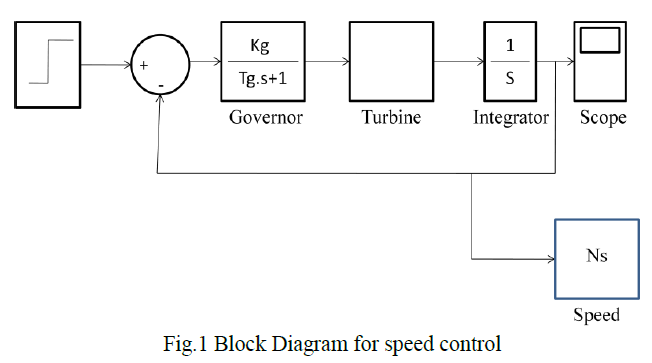 |
| The governor which acts as a control valve will be used to throttle the amount of steam that is going to the turbine section. The governor opening is being controlled by a PID, FUZZY PID and MPC controller which is in the electronic governor control panel. |
II.MODELING OF STEAM TURBINE |
| Tandem-compound single-reheat steam turbine assembly consists of four stages all in line on the same shaft but can have several casings. The superheated steam enters the High Pressure stage (HP) where it expands through the small diameter rotor blades before exiting and being returned to the boiler. In the boiler the steam is superheated again and is directed to the Intermediate Pressure stage (IP). Here it expands through larger diameter rotor blades exiting to the Low Pressure turbines. In the final stage there are two identical sets of Low Pressure turbines (Dual LP). The exiting steam from the IP turbine is divided equally between the two turbines passing through quite large diameter rotors and blades. The steam expands through both of the LP turbines by being drawn into the vacuum condenser. |
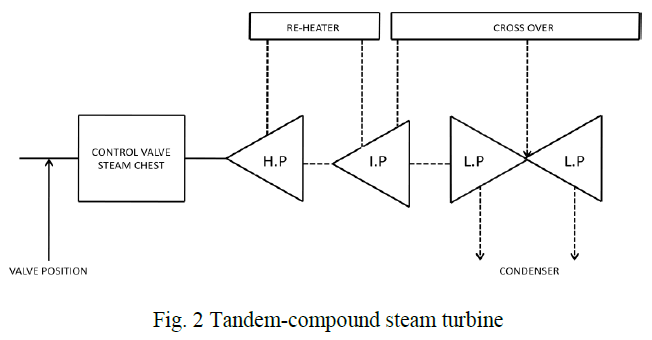 |
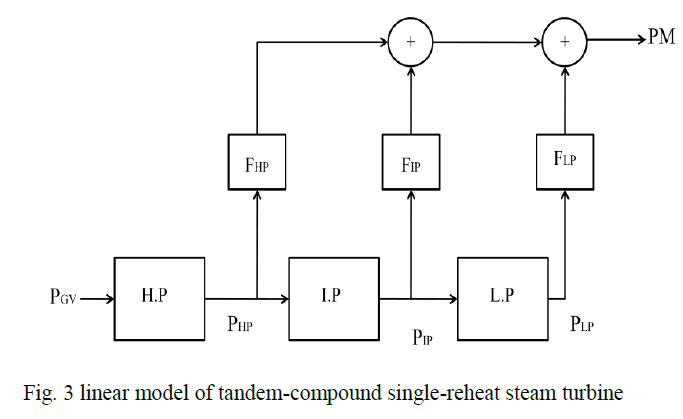 |
| The actual transfer function for steam turbine |
 |
III. PID CONTROLLER |
| The PID controller is the most common form of feedback. It was an essential element of early governors and it became the standard tool when process control emerged in the 1940s. In process control today, more than95% of the control loops are of PID type, most loops are actually PI control. PID controllers are today found in all areas where control is used. The controllers come in many different forms. There are stand-alone systems in boxes for one or a few loops, which are manufactured thousands yearly. PID control is an important ingredient of a distributed control system. The controllers are also embedded in many special-purpose control systems. PID control is often combined with logic, sequential functions, selectors, and simple function blocks to build the complicated automation systems used for energy production, transportation, and manufacturing. Many sophisticated control strategies, such as model predictive control, are also organized hierarchically. PID control issued at the lowest level; the multivariable controller gives the set points to the controllers at the lower level. The PID controller can thus be said to be the “bread and butter’ ’of control engineering. It is an important component in every control engineer’s tool box.PID controllers have survived many changes in technology, from mechanics and pneumatics to microprocessors via electronic tubes, transistors, integrated circuits. The microprocessor has had a dramatic influence on the PID controller. Practically all PID controllers made today are based on microprocessors. This has given opportunities to provide additional features like automatic tuning, gain scheduling, and continuous adaptation. |
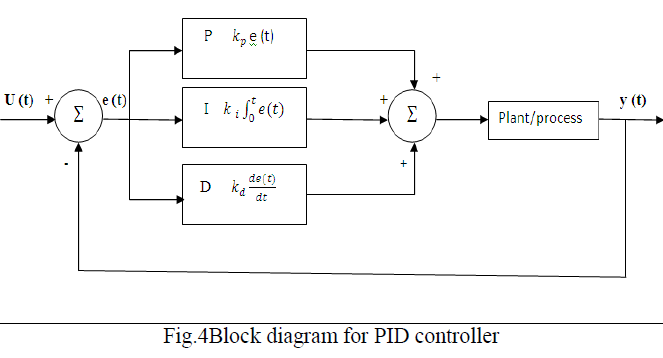 |
| The controller attempts to minimize the error by adjusting the process control inputs. The PID controller calculation algorithm involves three separate constant parameters, and is accordingly sometimes called three-term control: the proportional, the integral and derivative values, denoted P,I, and D. Heuristically, these values can be interpreted in terms of time: P depends on the present error, I on the accumulation of past errors, and D is a prediction of future errors, based on current rate of change. The weighted sum of these three actions is used to adjust the process via a control element. |
| Tuning the parameters of a PID controller is very important in PID control. Ziegler and Nichols proposed the well - known Ziegler-Nichols method to tune the coefficients of a PID controller. This tuning method is very simple, but cannot guarantee to be always effective. |
| The PID control scheme is named after its three correcting terms, whose sum constitutes the manipulated variable (MV). The proportional, integral, and derivative terms are summed to calculate the output of the PID controller. Defining as the controller output, ïÿýïÿý ïÿýïÿý the final form of the PID algorithm is: |
 |
| Where |
| Kp: Proportional gain, a tuning parameter |
| Ki: Integral gain, a tuning parameter |
| Kd: Derivative gain, a tuning parameter |
| e: Error |
| Tuning a control loop is the adjustment of its control parameters (proportional band/gain, integral gain/reset, derivative gain/rate) to the optimum values for the desired control response. |
FUZZY PID CONTROLLER |
| Fuzzy controllers are inherently nonlinear controllers, and hence fuzzy control technology can be viewed as a new, cost effective and practical way of developing nonlinear controllers. The major advantage of this technology over the traditional control technology is its capability of capturing and utilizing qualitative human experience and knowledge in a quantitative manner through the use of fuzzy sets, fuzzy rules and fuzzy logic. There exist two different types of fuzzy controllers: the Mamdani type and the Takagi±Sugeno (TS, for short) type. They mainly differ in the fuzzy rule consequent: a Mamdani fuzzy controller utilizes fuzzy sets as the consequent whereas a TS fuzzy controller employs linear functions of input variables Although it is possible to design a fuzzy logic controller by a simple modification of the conventional ones, via inserting some meaningful fuzzy logic IF- THEN rules into the control system, these approaches in general complicate the overall design and do not come up with new fuzzy PID controllers that capture the essential characteristics and nature of the conventional PID controllers. Besides, they generally do not have analytic formulas to use for control specification and stability analysis. The fuzzy PID controllers to be introduced below are natural extensions of their conventional versions, which preserve the linear structures of the PID controllers, with simple and conventional analytical formulas as the final results of the design. Thus, they can directly replace the conventional PID controllers in any operating control systems (plants, processes). The conventional design of PID controller was somewhat modified and a new hybrid fuzzy PID controller was designed. Instead of summation effect a mamdani based fuzzy inference system is implemented. The inputs to the mamdani based fuzzy inference system are error and change in error. |
 |
| The main difference is that these fuzzy PID controllers are designed by employing fuzzy logic control principles and techniques, to obtain new controllers that possess analytical formulas very similar to the conventional digital PID controllers in a fuzzy logic system, the membership function is the operation that translates crisp input data into a membership degree |
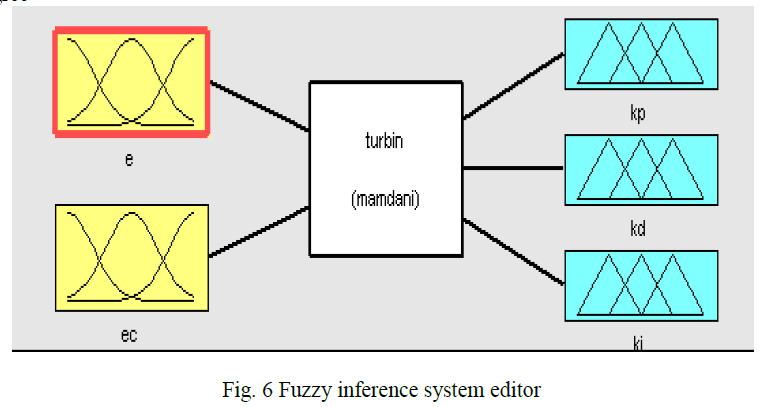 |
| The principle of fuzzy self-tuning PID is firstly to find out the fuzzy relationship between three parameters of PID and error (e) and error changes (ec). Fuzzy inference engines modify three parameters to be content with the demands of the control system online through constantly checking e and ec . Thus, the real plant will have better dynamic and steady performance |
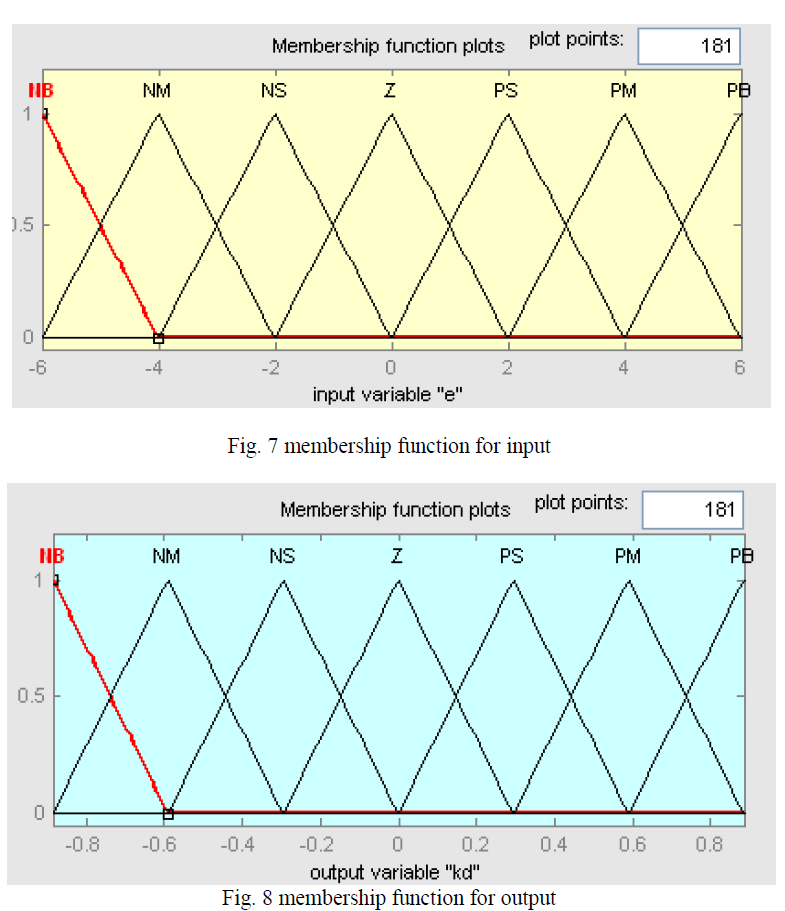 |
A. Fuzzy rule base |
| A set of rules which define the relation between the input and output of fuzzy controller can be found using the available knowledge in the area of designing the system. The self tuning rule is deferent according to different e, ec, kp, ki and kd. These rules are defined using the linguistic variables. The two inputs, error and rate of change in error, result in 49 rules. |
IV. MODEL PREDICTIVE CONTROL |
| Model predictive control (MPC) refers to a class of computer control algorithms that utilize an explicit process model to predict the future response of a plant. At each control interval an MPC algorithm attempts to optimize future plant behaviour by computing a sequence of future manipulated variable adjustments. The first input in the optimal sequence is then sent into the plant, and the entire calculation is repeated at subsequent control intervals. Originally developed to meet the specialized control needs of power plants and petroleum refineries, MPC technology can now be found in a wide variety of application areas including chemicals, food processing, automotive, and aerospace applications. |
| Predictive algorithms consist of two tasks. First, a free response is predicted over a finite time horizon called the prediction horizon. The free response is predicted assuming that the control variables remain at their current values in the future. The modelling error is taken into account during the prediction. After the free response prediction, such control actions are calculated that the actions and the corresponding predicted control errors optimize the formulated cost function. The cost function consists of the control efforts, the control errors, and the constraints for control signals and measured process values connected with the control loop. The optimal control actions are calculated using M control steps. M is called the control horizon. Finally only the first control step is implemented. These steps are repeated at every control cycle. |
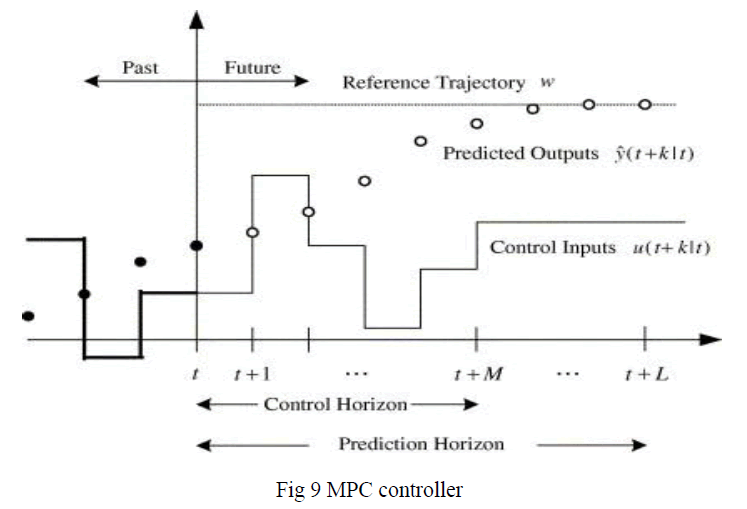 |
| The tuning of the MPC is based on the selection of the lengths of prediction and control horizons, cost function weighing factors, and the parameters of the noise model included in the internal model of the controller. The controller inputs for the boiler MPC is the turbine inlet flow as a feed forward signal. The linear controller model is identified from the simulated nonlinear process data. The length of the prediction horizon was selected according to the dominating time constant of the boiler process. The control horizon was selected short (1 step) in order to smooth the control actions. With the long control horizon (many steps available to move the state of the process to the set point) control actions tend to be more aggressive than with the short horizon. Model Predictive Control is an open loop control design procedure based on obtaining plant measurements and predicting future outputs by means of a model of the process. This is done at each sampling time k. These predictions are used to compute m control moves by minimizing an objective function ïÿýïÿýïÿýïÿý(k), defined over a prediction horizon p as follows: |
 |
| Although more than one optimal control input is computed, only the first computed control move is implemented. At the next sampling time k + 1, new measurements are obtained from the plant and the optimization problem is solved again. Both the control horizon m and the prediction horizon p move or recede ahead by one step as time moves ahead by one step. This is the reason why MPC is also sometimes referred to as Receding Horizon Control (RHC) or Moving Horizon Control (MHC). The purpose of taking new measurements at each time step is to compensate for unmeasured disturbances and model inaccuracy both of which cause the system output to be different from the one predicted by the model. |
V. RESULTS AND DISCUSSION |
| Tandem compound single reheat turbine is modelled by using state space method and fig 10 shows open loop step response of the obtained transfer function |
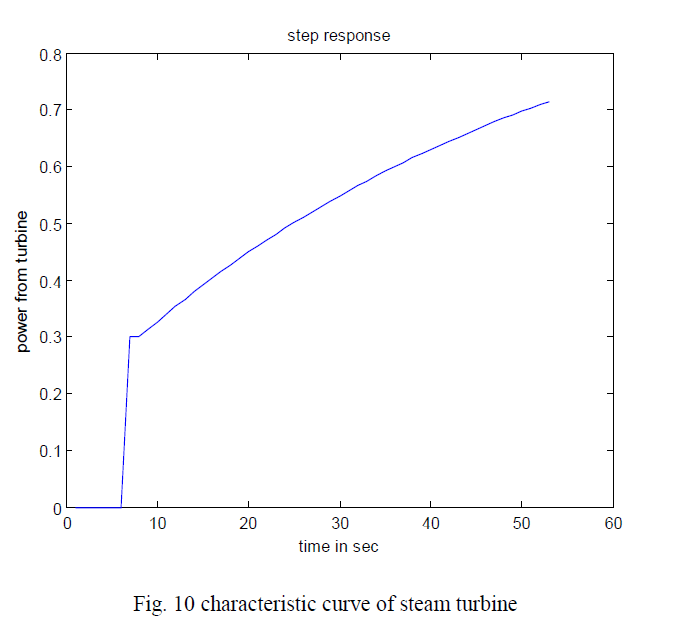 |
| PID controller is designed and tuned using Ziegler Nichols method, fig 11 shows obtained speed response and it takes about 30 seconds for the response to settle down. |
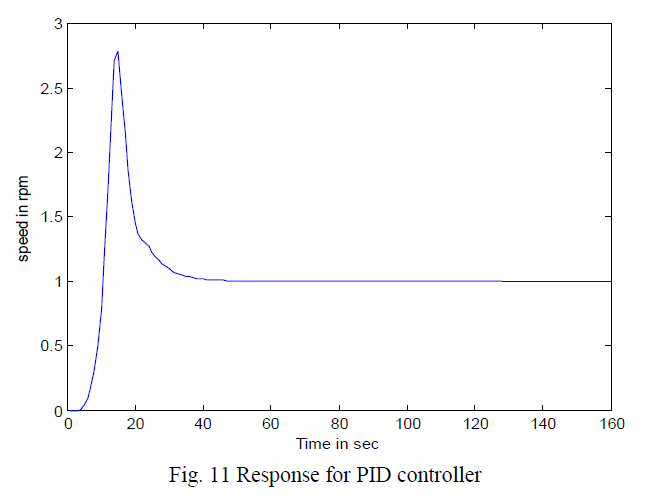 |
| Existing PID controller is modified by connecting fuzzy interface.PID will be tuned based on fuzzy rules. Fig 12 shows response of fuzzy PID controller .performance of process improves when Fuzzy PID controller is used and settling time is about 15 seconds |
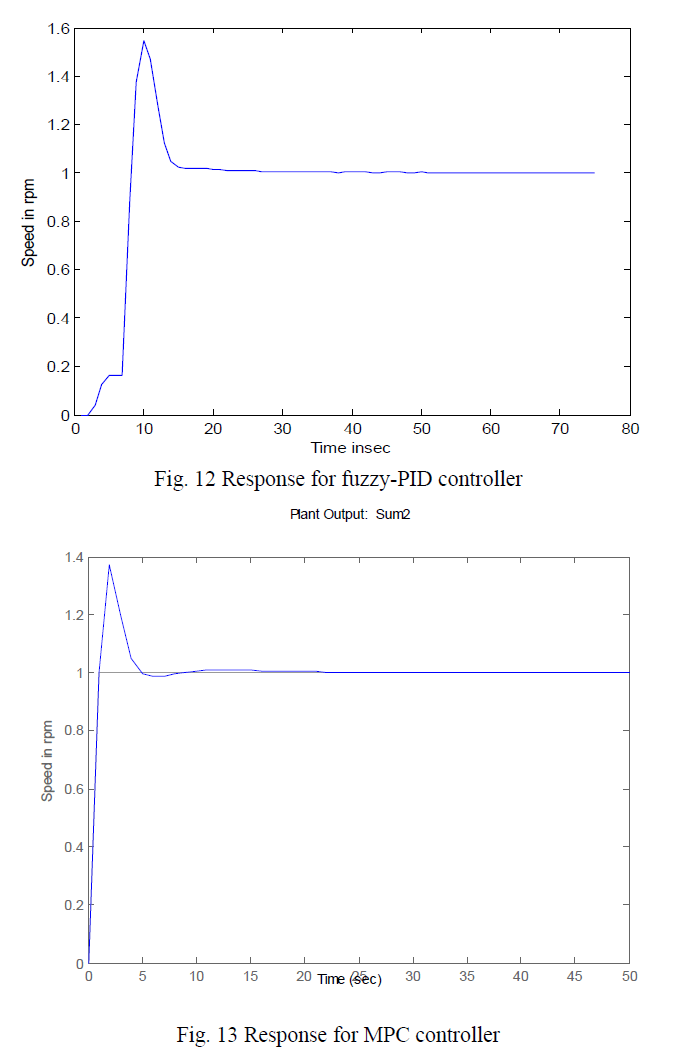 |
| From the above fig 13 its clear that settling time while using a PID controller and fuzzy PID controller can be reduced by using a MPC controller and settling time is only 8 seconds. |
VI. CONCLUSION |
| This thesis investigated the effectiveness of different controllers for the speed control of Tandem compound single reheat steam turbine. The speed of a Tandem compound single reheat steam turbine was controlled using the proposed MPC controller. The details of development of the proposed controller were presented. Then the results of the comparison of the proposed controller with the traditional PID controller and fuzzy PID controllers were also presented in this work. |
| According to the simulation results in MATLAB, show that the proposed MPC can improve the robustness and small overshoot and fast response compared to the conventional PID and fuzzy PID. In the area of turbine speed control the faster response to research stability, the better is the result for the plant. |
References |
|